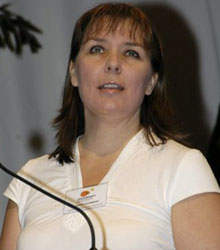
Dr Sarah Rummery
Two researchers from Charles Darwin University gave an overview of the Northern Territory economy and its labour force as part of the Symposium in Alice Springs.
Professor Tony Barnes and Dr Sarah Rummery, of the School for Social and Policy Research, highlighted some of the more unusual characteristics of the NT economy, demographic trends and some challenges for planners.
Professor Barnes, who until recently was also Senior Director of Economic and Social Analysis in the Northern Territory Treasury, said there were two economies, two populations and two labour forces in the NT, and that the Territory had characteristics that set it apart from the rest of Australia.
The median age in the NT was 30.9 years, six years younger than the median age nationally.
Some 31.6 per cent of the NT population was Indigenous, compared with 2.5 per cent nationally.
The Territory also had relatively few residents over the age of 60, but had more people in the 30 to 40 year age bracket, and more children, compared with the rest of Australia.
Professor Barnes said that the non-Indigenous population had some peculiar features, including that after the age of 50 there were three men for every two women which would create a “whole set of social issues as this section of the population ages further”.
He said that a large bulge in the figures in the 40 to 60 age bracket in the non-Indigenous population helped to explain an observation of an earlier speaker that the Territory has a high proportion of older-age people in executive positions.
The level of schooling achieved in a population is a broad indicator of its preparedness for work.
Professor Barnes said the 2006 Census showed that 40 per cent of Indigenous Territorians completed Year 10, compared with 89 per cent of the non-Indigenous population.
Dr Sarah Rummery provided an overview of the Territory economy, which, she said, was volatile in terms of growth rates.
The NT’s economic peaks were based around major projects and the price of commodities such as production from oil fields in the Timor Sea, construction of the Alice Springs to Darwin rail line, and the development of gas resources.
Dr Rummery said the NT economy was inherently different from the rest of Australia with mining, government administration and defence being the stand-out activities in the Territory.
Mining accounted for between six and seven per cent of the economy in the rest of Australia, but represented about 23 per cent of the NT economy.
While mining and energy were significant to the NT economy, they were not huge employers.
Many mine and energy industry workers did not add significantly to the NT population because of a tendency for companies to fly these workers in and out from West Australia or Queensland, she said.
The biggest employers in the NT were government, administration, defence, health and education.
Tourism, accommodation, cultural and recreational services also were significant to the NT economy.
She said that a key point was that the NT was a small economy compared with other states, was export-orientated and commodity-driven.
Employment levels in the past few years in the NT had shown a significant increase with the Territory now enjoying historically high levels.
The highest growth was in full-time jobs. Some 21,000 people worked part-time work.
Indigenous employment in the Territory has been showing declines in recent years, and although the latest figures showed an improvement, it was still behind the rate for the rest of Australia.
Dr Rummery said that the unemployment rate across the Territory stood at 2.9% at the end of 2006, and that unemployment in the 15 to 19 year age bracket was at a 10-year low.
Professor Barnes said that with a booming economy there was very nearly complete employment in the non-Indigenous population, but there remained a large amount of under-employment in the Territory’s Indigenous population.